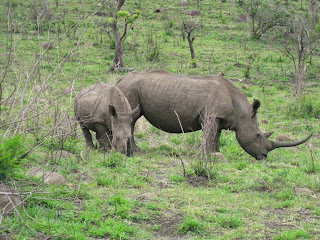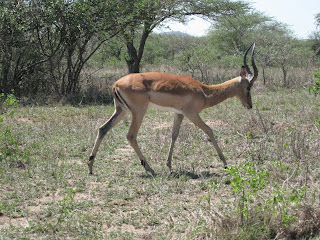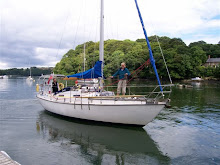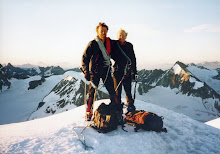We sailed from Dampier (NW Australia) on 20th August 2014 and embarked on the 1,200 mile passage to Cocos Keeling. We managed to average 100 miles per day, so the passage took us the expected twelve days. The start was very slow and quite frustrating. For the rest though, it was trade wind sailing, with 10 to 15 knots of wind from astern.
Cocos Keeling
We arrived at Cocas Keeling on the 2nd September and it proved to be a very pleasant, almost shark
free group of islands, and we delighted to be able to swim from Sula once
again. The water was clear and warm and very inviting.
There were though, several Black Tipped Sharks! They are reputed to be human friendly and indeed showed no interest in us. Shark and friendly aren’t two words I would normally use in the same sentence. I prefer to swim when there are no sharks to be seen.
There were though, several Black Tipped Sharks! They are reputed to be human friendly and indeed showed no interest in us. Shark and friendly aren’t two words I would normally use in the same sentence. I prefer to swim when there are no sharks to be seen.
Cocas
Keeling
The principal islands in the group that make up Cocos
Keeling are Direction Island, where we anchored, Home Island, South Island, and
West Island. In order to clear customs we had to visit West Island.
We therefore caught the ferry that went first to Home
Island, and then on to West Island. Simple enough you might think. Fortunately,
we discovered before it was too late, that the ferry returned to Home Island,
but not to our anchorage at Direction Island.
We were unable to find out why they didn’t do so.
Apparently the only way to get to West Island and back in a day is to take ones
tender to Home Island, then
catch the ferry that returns and terminates there.
Simple enough if you have a large motor on your tender, but out of the question for us to paddle the 1½ miles directly into the trade wind blowing 15 to 20 knots. We explained the problem to the customs officer by VHF radio. He was most helpful. Don’t worry, he said, we will come to you. Well, he did, eventually, on the day before we sailed for Reunion!
Simple enough if you have a large motor on your tender, but out of the question for us to paddle the 1½ miles directly into the trade wind blowing 15 to 20 knots. We explained the problem to the customs officer by VHF radio. He was most helpful. Don’t worry, he said, we will come to you. Well, he did, eventually, on the day before we sailed for Reunion!
Passage
to Reunion, 14th to 30th September.
The weather was good and the trade winds blew us along
nicely most of the way. On the 25,th
26,th and 27th
though, it was a tad too strong and we had to put the 3rd reef in
the mainsail. We arrived in Reunion in the early hours of the 30th,
so chose to heave-to and await day break before entering harbour.
Port
de Galets (Reunion harbour).
Reunion harbour was rather a disappointment. Our berth
was opposite the local fishermen’s ice making plant. It ran noisily for much of
the day and evening. However, the mountains in the distance winked at us
immediately.
Jerome, the harbour master, was very helpful. He turned out to be a fell runner and was to join us for a walk on the mountain in the photograph above.
Jerome, the harbour master, was very helpful. He turned out to be a fell runner and was to join us for a walk on the mountain in the photograph above.
There are certainly many splendid parts of Reunion, but
there are many rather grotty parts too. The dense traffic was also a shock to us.
The
only sea swimming in Reunion is in a few reef pools.
Once we had settled in and found our land legs, we joined
up with Chris and Fi from the yacht Three Ships, for some hill and coast walks.
Our first outing was to the Grand Basin. It came as a bit
of a shock to discover that it wasn’t a climb at all, but a descent to a Roadless,
remote village, whose only access was by helicopter or on foot. It was a very
hot day, so we only went half way, sensibly saving some energy for the climb
back up.
The
Grand Basin
Our next two outings were to the Grand Etang, a gentle
walk around a rather pretty lake with a fine waterfall.( In the rain) Then Le
Roc Ecrite, a long hot walk, in the mist at first, but eventually above the
cloud.
So now we were finding our land legs, though the
muscles were conspicuous by their absence.
Jerome, the harbour master and fell runner, and his
wife Jesse, joined us for an ascent of the Grand Benard. It was cloudy as we
set out, but we eventually climbed above the cloud and were rewarded by
spectacular views. We climbed a long, but not too steep ridge to the summit and
descended by the same route.
Grand
Bernard 1
Grand
Bernard 2
Grand
Bernard 3
Grand
Bernard 4
Climbing Sailors /Sailing climbers
Our final expedition was rather less strenuous, but required
a 0430 start, to avoid the traffic. We were to visit the islands largest
volcano. The Piton de la Fournaise, an active volcano that last erupted in June
2014.
To be honest I wasn’t particularly looking forward to this trip. I much
prefer doing things, rather than just looking at them. Well, I’m so glad that I
went along with it. It was a grand day out. The views were spectacular, and the
scale of the volcano’s original rim astonishing. There were large secondary craters within the original massive
one. I was also astonished with the speed that plants were re colonising.
New
growth on the lava fields.
The
main volcano rim.
As it happened we had a good passage, with only one
stiff blow and then, surprisingly, calms as we approached Richard’s Bay. At one
point in the wee
small hours I decided to heave to and put the 3rd reef in the main sail. There was a lightning storm and heavy rain and our speed over the ground was a good seven knots. We had obviously found a favourable ocean current. It was so peaceful being hove to that I, rather lazily, stayed that way until dawn and had a good rest.
small hours I decided to heave to and put the 3rd reef in the main sail. There was a lightning storm and heavy rain and our speed over the ground was a good seven knots. We had obviously found a favourable ocean current. It was so peaceful being hove to that I, rather lazily, stayed that way until dawn and had a good rest.
The
passage to South Africa.
As we approached South Africa, in very light and
sometimes head winds, I picked up transmissions from Peri Peri radio net. They
forecast strong winds for our entrance to Richards Bay. Disappointing news
indeed. However luck was with us. The next day they told us that the forecast
low had filled and that we could now expect fair weather for the rest of our
passage. We celebrated that news.
We entered Tuzi Gazi Marina (Richard’s Bay) at 1am on
the 3rd of November and tied up to the customs wharf, then had a wee
dram to celebrate our arrival in South Africa.
Lawrence and Lorcan, husband/daughter of Ann, the Ocean
Cruising Club Port officer, helped us to a berth in the marina. Customs, Police
and Immigration officers visited us in turn, and dealt with the paperwork most
efficiently. Then Lawrence arrived again and took us to the supermarket and on
a conducted tour of Tuzi Gazi. What splendid people.
Fi and Chris from Three Ships, who had arrived a few
days previously, invited us aboard for an evening meal. We gratefully accepted
the invitation, but warned them that we might fall asleep at their dining
table.
A few days later we joined Fi and Chris for a three day
tour of Hluhluwe & Imfolosi National Parks. It was just wonderful. At one
stage we stopped the car a safe distance from a group of elephants who had
chosen to walk on the road. We had been warned not to get too close to them.
But then we noticed that the rest of the herd had joined the road behind us! We
were surrounded by about thirty elephants. There was nothing we could do, so we
just sat there snapping away with our cameras and trusting that they would walk
round us, rather than over us.
We have been back from that safari for just three days,
and Pippa, bless her, has organised for just the two of us, to visit some other
parks in the vicinity.
We like South Africa and are in no rush to move on. But
when we do, it will be to make relatively short hops along the coast to Cape
Town.The idea is to allow one low pressure system to pass through, then to sail
to the next port before another arrives.
For the very latest news of our travels, check out the
“Where are we now” and “Post Script” sections of this blog.
Here are a few ahhh photos.
Zebra
Warthog
White
Rhino
Impala
Giraffe
Elephant
Dung
Beetle






















